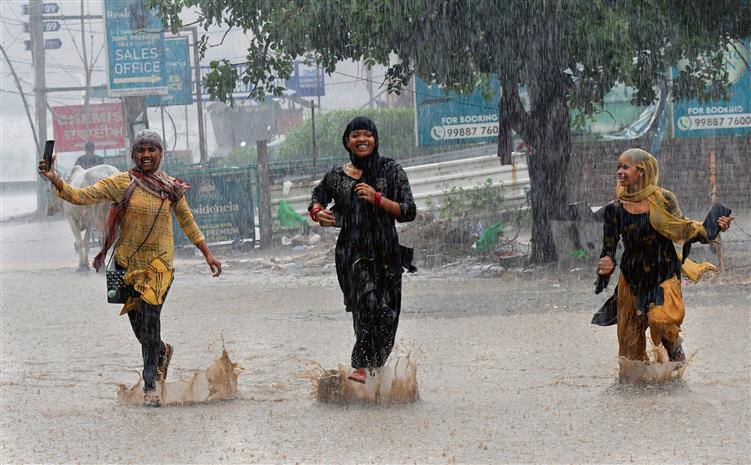How monsoon defines us
Bindu Menon
In Intizar Husain’s story ‘Clouds’, a boy is perturbed by the disappearance of clouds and goes searching for them. He asks everyone if they have seen a passing cloud, but no one seems to know or care. One old man ruminates that the rain will come only if God wills it and rues that “the sky has turned miserly, and the earth is no longer benevolent”. But the boy barely gets the import of the man’s words. He only wants to see the clouds. When he finally returns home after a long search, he finds that it has already rained and his beloved jamun tree is glistening in the courtyard. Hopefully, he looks up but finds a clear sky, emptied of the rain. Wistfully, he realises that the clouds have eluded him again.
As the southwest monsoon advances, the clouds are not so elusive. The monsoon seems to hold the nation in its thrall, putting it on track and sometimes off it. No season in India is preceded by so much longing, nor triggers as much loathing when it overstays its welcome or unleashes its fury. No other season grips the senses and the soul as the monsoon: from the invigorating scent of damp earth to the rhythmic symphony that rises from a pitter-patter to a pounding frenzy, from its awe-inspiring visual exuberance to the visceral aliveness that a walk in the rain can offer. No season perhaps captures nature in all its manifestations: its beauty, bounty and benevolence. Or its fury, ferocity and fickleness.
We seem to share an organic bond with the rain. It evokes comforting memories of playing with paper boats and puddles and a yearning for some piping hot tea and pakoras. Khushwant Singh once wrote that to know India and its people, one must know the monsoon, for “what the four seasons of the year mean to the European, the one season of the monsoon means to the Indian”. In his 1956 novel ‘Train to Pakistan’, Singh vividly describes the onset of monsoon as an “ebony wall coming up from the east” and paints a theatrical vision of its coming — “There is a flash of lightning which outshines the daylight. The wind fills the black sails of the clouds and they billow out across the sun. A profound shadow falls on the earth. There is another clap of thunder. Big drops of rain fall and dry up in the dust: A fragrant smell rises from the earth… It has come! Sheets of water, wave after wave.”
The word ‘monsoon’ entered the English language in the 16th century, probably picked up from Arab sailors and derived from the Arabic word ‘mawsim’ or the Urdu ‘mausam’. In his book ‘Unruly Waters’, which surveys the expansive history of Asia through its riverine culture and rains, historian Sunil Amrith points to two statements that bring out the significance of the monsoon in India. One by former Prime Minister Indira Gandhi in the late 1960s when she said, “For us in India, scarcity is only a missed monsoon away.” The other is by environmental activist Sunita Narain at a lecture in Harvard, where she famously declared that “India’s finance minister is the monsoon”.
In popular imagination, the rain is embedded with all kinds of emotion, myths and cultural memories. In Kalidasa’s ‘Meghaduta’, the emotion is of viraha (longing) and hope when a banished yaksha pines for his beloved and enlists the help of a cloud to send her a message. In mythology, there is the story of Rishyasringa, a young ascetic who must be seduced so that he can bring rain to a parched kingdom. In musical lore, Tansen’s rendering of the heat-inducing and lamp-igniting Raag Deepak takes such a toll on his health that he is saved only by the rendition of the rain-invoking Raag Megh Malhar.
Alluding to the rain, Jayanta Mahapatra once observed that there are two things which connect human beings: what is above and what is below. “The sky is above you and the earth beneath you and anything that connects earth and sky is rain. It is a bond you cannot miss,” the poet said, calling the rain the very act of living. In similar vein, fellow poet Walt Whitman describes it as the “poem of earth” that impalpably rises from the land and bottomless seas upward to heaven and cleanses and rejuvenates the earth, while Khalil Gibran eloquently visualises it as “the sigh of the sea, the laughter of the field, the tears of heaven”.
Rain brings hope and joy, it can also be dark and bleak. Such is life too. And therefore, as American poet Henry Wadsworth Longfellow says, “Into each life, some rain must fall.”









